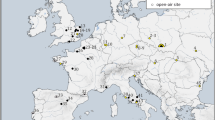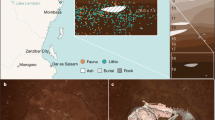Abstract
Excavations in a cave in the Oblazowa Rock in south Poland revealed an Upper Palaeolithic cultural level with an abundance of lithic and organic artefacts as well as palaeozoological material. This level yielded a fragment of mammoth tusk showing the characteristic traits of a complete boomerang. This is the earliest certain find of this type of weapon in the world. The same layer also contained an adult distal thumb phalanx which represents the earliest find of human skeletal material in Poland to date. Human food debris in the cultural layer suggests that the Upper Palaeolithic people inhabiting the cave hunted reindeer for the most part. The faunal complex of this cultural level is typical of the Upper Pleistocene steppe–tundra, while the artefacts belong within the complex of Central European cultures with backed points and have attributes which allow them to be grouped within the Pavlov culture dating from ~23,000 yr BP. The site might have been of importance in the course of migration of human groups with backed points from today's Moravia and southwestern Slovakia regions north-eastwards to the Don river basin.
This is a preview of subscription content, access via your institution
Access options
Subscribe to this journal
Receive 51 print issues and online access
$199.00 per year
only $3.90 per issue
Buy this article
- Purchase on Springer Link
- Instant access to full article PDF
Prices may be subject to local taxes which are calculated during checkout
Similar content being viewed by others
References
Thomas, J. New Scient. 99, 838–843 (1983).
Bell, J. New Scient. 99, 839 (1983).
Peter, H. Wesen und Bedeutung des Bumerangs (Braumüller, Vienna, 1986).
Hess, F. Antiquity 47, 303–306 (1973).
Schwantes, G. Deutschlands Urgeschichte (Quelle and Meyer, Leipzig, 1934).
Kriegler, K. Acta praehist. 3/4, 6–13 (1962).
Menghin, O. F. A. Acta praehist. 3/4, 14–34 (1962).
Kowalski, K. Jaskinie Polski. Vol. 3 (Panstwowe Wydawnictwo Naukowe, Warsaw, 1954).
Birkenmajer, K. Przewodnik geologiczny po pieninskim pasie skalkowym (Wydawnictwa Geologiczne, Warsaw, 1979).
Kozlowski, J. K. & Kozlowski, S. K. Pradzieje Europy od XL do IV tysiaclecia p.n.e. (Panstwowe Wydawnictwo Naukowe, Warsaw, 1975).
Author information
Authors and Affiliations
Rights and permissions
About this article
Cite this article
Valde-Nowak, P., Nadachowski, A. & Wolsan, M. Upper Palaeolithic boomerang made of a mammoth tusk in south Poland. Nature 329, 436–438 (1987). https://doi.org/10.1038/329436a0
Received:
Accepted:
Issue Date:
DOI: https://doi.org/10.1038/329436a0
This article is cited by
-
The Beginning of the Early Upper Paleolithic in Poland
Journal of Paleolithic Archaeology (2023)
-
The Use of Wooden Clubs and Throwing Sticks among Recent Foragers
Human Nature (2023)
-
A 300,000-year-old throwing stick from Schöningen, northern Germany, documents the evolution of human hunting
Nature Ecology & Evolution (2020)
-
From the apron into the pit: the deposition of the complete debris from the manufacture of a bifacial preform at the Middle Paleolithic site of Kabazi V, level III/4-2
Archaeological and Anthropological Sciences (2020)
-
The impact of major warming at 14.7 ka on environmental changes and activity of Final Palaeolithic hunters at a local scale (Orawa-Nowy Targ Basin, Western Carpathians, Poland
Archaeological and Anthropological Sciences (2020)
Comments
By submitting a comment you agree to abide by our Terms and Community Guidelines. If you find something abusive or that does not comply with our terms or guidelines please flag it as inappropriate.



